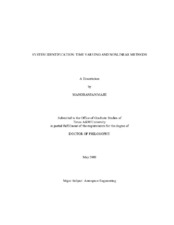| dc.contributor.advisor | Junkins, John L. | |
| dc.creator | Majji, Manoranjan | |
| dc.date.accessioned | 2010-07-15T00:13:14Z | |
| dc.date.accessioned | 2010-07-23T21:44:35Z | |
| dc.date.available | 2010-07-15T00:13:14Z | |
| dc.date.available | 2010-07-23T21:44:35Z | |
| dc.date.created | 2009-05 | |
| dc.date.issued | 2010-07-14 | |
| dc.date.submitted | May 2009 | |
| dc.identifier.uri | https://hdl.handle.net/1969.1/ETD-TAMU-2009-05-637 | |
| dc.description.abstract | Novel methods of system identification are developed in this dissertation. First
set of methods are designed to realize time varying linear dynamical system models from
input-output experimental data. The preliminary results obtained in a recent paper by the
author are extended to establish a new algorithm called the Time Varying Eigensystem
Realization Algorithm (TVERA). The central aim of this algorithm is to obtain a linear,
time varying, discrete time model sequence of the dynamic system directly from the
input-output data. Important results relating to concepts concerning coordinate systems
for linear time varying systems are developed (discrete time theory) and an intuitive
understanding of equivalent realizations is provided. A procedure to develop first few
time step models is detailed, providing a unified solution to the time varying
identification problem.
The practical problem of identifying the time varying generalized Markov
parameters required for TVERA is presented as the next result. In the process, we
generalize the classical time invariant input output AutoRegressive model with an
eXogenous input (ARX) models to the time varying case and realize an asymptotically stable observer as a byproduct of the calculations. It is further found that the choice of
the generalized time varying ARX model (GTV-ARX) can be set to realize a time
varying dead beat observer.
Methods to use the developed algorithm(s) in this research are then considered
for application to the identification of system models that are bilinear in nature. The fact
that bilinear plant models become linear for constant inputs is used in the development
of an algorithm that generalizes the classical developments of Juang.
An intercept problem is considered as a candidate for application of the time
varying identification scheme, where departure motion dynamics model sequence is
calculated about a nominal trajectory with suboptimal performance owing to the
presence of unstructured perturbations. Control application is subsequently
demonstrated.
The dynamics of a particle in a rotating tube is considered next for identification
using the time varying eigensystem realization algorithm. Continuous time bilinear
system identification method is demonstrated using the particle example and the
identification of an automobile brake model. | en |
| dc.format.mimetype | application/pdf | |
| dc.language.iso | eng | |
| dc.subject | System Identification | en |
| dc.subject | Linear Time Varying Systems | en |
| dc.subject | Eigensystem Realization Algorithm | en |
| dc.subject | Bilinear Systems | en |
| dc.subject | Guidance and Control | en |
| dc.subject | Dynamics. | en |
| dc.title | System Identification: Time Varying and Nonlinear Methods | en |
| dc.type | Book | en |
| dc.type | Thesis | en |
| thesis.degree.department | Aerospace Engineering | en |
| thesis.degree.discipline | Aerospace Engineering | en |
| thesis.degree.grantor | Texas A&M University | en |
| thesis.degree.name | Doctor of Philosophy | en |
| thesis.degree.level | Doctoral | en |
| dc.contributor.committeeMember | Juang, Jer-Nan | |
| dc.contributor.committeeMember | Vadali, Srinivas R. | |
| dc.contributor.committeeMember | Mortari, Daniele | |
| dc.contributor.committeeMember | Rednioitis, Othon K. | |
| dc.contributor.committeeMember | Datta, Aniruddha | |
| dc.type.genre | Electronic Dissertation | en |
| dc.type.material | text | en |


